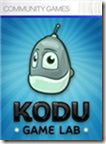One Option for How to Teach Kodu
 I recently ran some workshops to prepare students to be peer mentors and to mentor younger students with Kodu. The method I suggest is to have mentors show students some small steps and then let the students try. The latest version of Kodu has some really nice step by step lessons that students can do on their own or with a peer. After a lesson we encourage the students to try the same things on their own from where the lesson leaves off. For example adding a second character and having that character do something similar but slightly different from what was done in the lesson. I also encourage students to explore a little as well. They keep discovering things and sharing them with partners or others in the class. The general pattern of show a few things followed by experimentation with those things and repeat seems to work very well.
I recently ran some workshops to prepare students to be peer mentors and to mentor younger students with Kodu. The method I suggest is to have mentors show students some small steps and then let the students try. The latest version of Kodu has some really nice step by step lessons that students can do on their own or with a peer. After a lesson we encourage the students to try the same things on their own from where the lesson leaves off. For example adding a second character and having that character do something similar but slightly different from what was done in the lesson. I also encourage students to explore a little as well. They keep discovering things and sharing them with partners or others in the class. The general pattern of show a few things followed by experimentation with those things and repeat seems to work very well.
It can’t be all lecture/demo or students get bored. Kids just naturally want to try this stuff! On the other hand if you don’t stop and introduce new things students are likely to miss out on things. Although you can also count on some students learning things you didn’t know on a regular basis. Take those as teachable moments and use them to your advantage.
Students running into issues (bugs if you want) are an additional opportunity. This gives one a chance to talk about problem solving skills and how to look carefully at what is being asked of the program or not being asked. For example a common error when using additional code pages as sub routines is to forget to return to the original or other code page at an appropriate time. This is really an important programming concept that students can easily grasp using Kodu.
In our recent workshops which included high school and middle school students we gave the students a challenge list after the lunch break (we ran for three hours before lunch). That list looked like this:
- Create a new world with mountains and water
- Add several characters including some that move and some that don’t (like trees?)
- Program the movable objects to move on their own
- Keep some sort of score and act on it (e.g. win/lose game)
- Make some object jump
- Have fun!
Bonus:
- Use two score boards
- Use a path
- Create and use a second (or third) code page
- Make characters have a conversation (use When Hear)
- Use a “creatable” (adds copies of things to the game as it runs)
- Add intro text (background and/or instructions)
At the end of an hour we had students demonstrate and explain the projects they had created. I was amazed at what students were able to do in a short period of time. I can see creating a series of simple challenge lists for an after school program that would include both material that had been covered and some items for students to discover on their own.
There are also some curriculum resources at https://fuse.microsoft.com/page/kodu (scroll down to the Kodu Classroom Kit for Educators) Also on that page you will find some introductory videos and a link to the Kodu community at KoduGameLab.com The videos can be particularly useful since everything in Kodu is so visual. It is easier to show something than explain it.